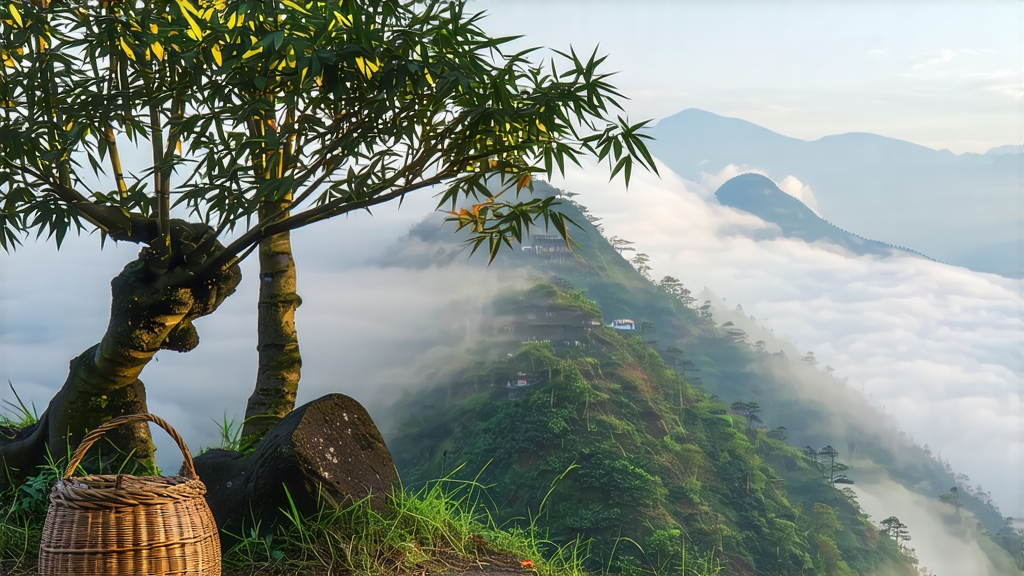
High on the shoulders of Sichuan’s sacred Meng Ding Shan, where perennial mist folds the granite cliffs into soft anonymity, a tea once reserved for emperors still unfurls its down-covered buds each early April. International drinkers may speak fluently of Long Jing or Da Hong Pao, yet the whispered name Meng Ding Huang Ya—literally “Meng Peak Yellow Bud”—rarely crosses the border. This essay invites the curious abroad to discover a yellow tea that history nearly erased, a liquor so gentle it feels like drinking the mountain’s own breath.
-
A leaf born under edict
Meng Ding Shan has been cultivated since the Western Han dynasty, but the first verifiable tribute entry of Huang Ya appears in a Tang-era ledger (AD 724) dispatched from Chengdu to Chang’an. The buds were carried in silk-lined bamboo tubes, changing horses every twenty li so that the tender leaves reached the palace within five days, still exhaling their orchid-like scent. Song dynasty emperor Huizong—himself a skilled tea aesthete—praised the tea’s “hidden sweetness like a recollected dream,” raising its annual levy to 240 kilograms, an astronomical amount when plucked one-tip-and-one-leaf at a time. After the collapse of imperial China the tribute system vanished; mountain monks quietly kept the cultivar alive in terraced plots no wider than a calligraphy scroll. Not until 1959 did a government expedition rediscover those isolated gardens, now protected by UNESCO’s World Heritage buffer zone. -
Of mountains and microclimates
Meng Ding Shan rises 1 456 m where the Sichuan basin meets the Tibetan plateau. Warm, moisture-laden air ascends the cliffs, cools, and condenses into a 220-day-a-year fog that filters sunlight into a soft, diffused glow. The tea bushes, mostly seed-propagated descendants of Tang-era Camellia sinensis var. sinensis, grow slowly on weathered granite soils rich in potassium and fluorine. The result is a bud densely packed with theanine and aromatic volatiles while staying low in bitter catechins—ideal chemistry for the delicate “sealed yellowing” that defines the category. -
From emerald to antique gold: the craft
Yellow tea is often mis-described as “green tea with an extra step.” In reality the supplementary men huang (“sealed yellowing”) phase rewires the leaf’s entire enzymatic timetable. Meng Ding Huang Ya undergoes:
a. Picking: only the unopened bud and the half-emerged first leaf, between 5:30 and 9:00 a.m., when the morning dew is still intact.
b. Sha Qing (kill-green): 75 °C on a slightly convex Meng Shan cast-iron pan, hand-flipped 48 times per minute for exactly 4 minutes to deactivate polyphenol oxidase while preserving a 7 % residual moisture.
c. Re-moistening: the leaves are piled in linen sacks for 20 minutes, allowing internal humidity to equalize—critical for uniform yellowing later.
d. Chu Bei (primary rolling): light pressure for 6 minutes to break surface cell walls without twisting the bud tip.
e. Men Huang (sealed yellowing): the leaf is wrapped in thick mulberry paper and placed inside a bamboo steam chamber at 35 °C and 78 % RH for 48–60 hours. During this hibernation chlorophyll degrades into pheophytin, catechins dimerize into theaflavins, and a honey-like aroma precursor (DMNT) increases threefold.
f. Fu Hong (secondary slow baking): charcoal from local walnut wood heats a pottery oven to 55 °C; the tea is dried in three passes, each followed by a 30-minute rest to allow “internal moisture migration.” Total baking time: 7 hours.
g. Final sorting: masters pluck out any blemished tips by tweezers under north-facing skylights, achieving a finished ratio of 9 000 buds per 100 g.
- How to brew it without bruising its soul
Water: spring or filtered, 85 °C. Anything hotter will flash-extract saponins and erase the signature velvety texture.
Leaf ratio: 3 g for 120 ml, or one heaping teaspoon per gaiwan.
Vessel: porcelain gaiwan or a